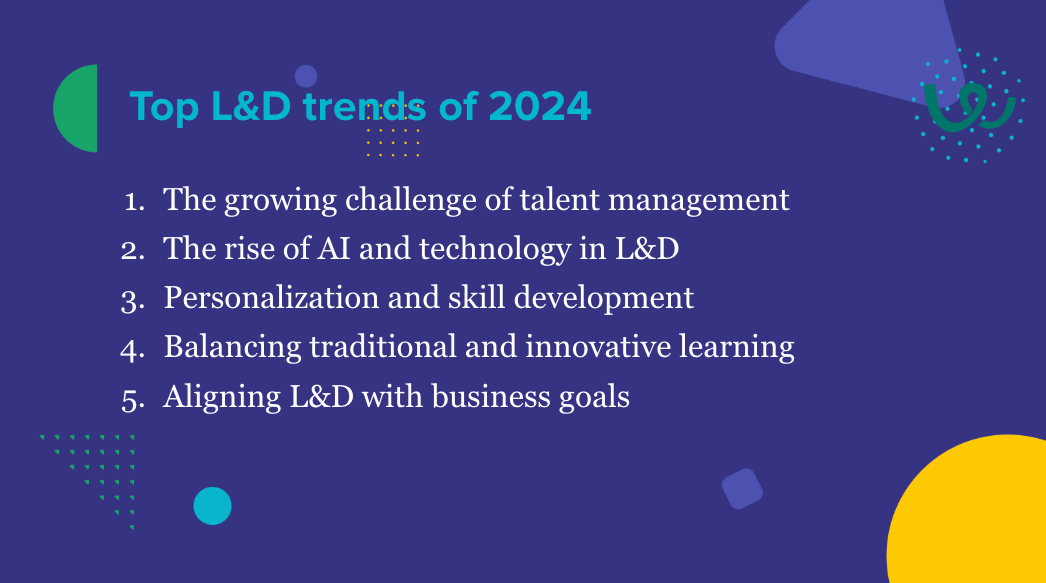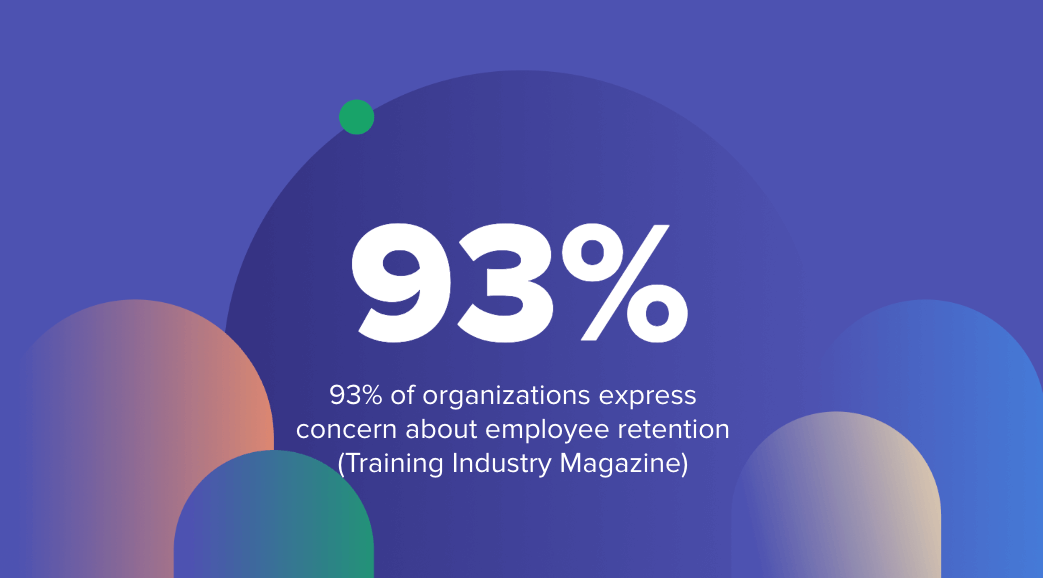L&D trends for 2024: reports find there’s no more one-size-fits-all
We have read four high-level reports about learning and development for you, and here are our thoughts. Navigate through the biggest trends, challenges, and opportunities based on four recent reports that will guide you throughout the year.

As HR professionals, we understand that the heart of any successful organization lies in its people. In 2024, as we embark on a new chapter in the world of Learning and Development (L&D), the challenges and opportunities that await us are more intriguing than ever before.
First things first, we need to understand how important learning and development (L&D) is for our employees.
Why should you boost L&D efforts for your people in 2024?
We have data now. The impact of training in 2023 has been profound, with a substantial majority of employees reaping its benefits.
According to a recent L&D report by TalentLMS and Vyond, an impressive 71% of workers report feeling significantly more prepared for the future of work, attributing their enhanced confidence to the training they received.
Furthermore, 72% have experienced career progression directly attributable to company-provided training, underscoring the pivotal role it plays in professional growth.
Notably, an overwhelming 73% express satisfaction with how well their training aligns with the in-demand skills of the job market, emphasizing the relevance and currency of their learning experiences.
However, the journey of self-improvement is far from over, as 66% of employees acknowledge the need to continually develop new skills to thrive in their current positions, highlighting the ongoing importance of a learning mindset in today’s dynamic work environment.

L&D trends that you should consider in 2024
If you want to retain your best people and have a successful talent management process, then you might be interested in the following five key trends that are shaping the future of L&D.
1. The growing challenge of talent management
Let’s start by diving into one of the most pressing concerns facing HR departments around the globe: talent management. According to the 2024 HR/L&D Trends Survey by Blanchard, a staggering 87% of respondents anticipate that hiring will continue to be a challenge in the year 2024.
This finding underscores the ongoing battle to attract top talent in an increasingly competitive job market.
But the challenges don’t end there. An even higher percentage, 88%, believe that employee retention will also pose a significant challenge in the coming year.

Furthermore, the 2024 Business Perspectives on Managing World-Class Training by Training Industry Magazine, reveals that 93% of organizations share this concern about employee retention, highlighting the widespread industry apprehension regarding talent retention.
In an era where talented individuals have more options than ever, keeping your best and brightest on board is a complex task.
In an era where talented individuals have more options than ever, keeping your best and brightest on board is a complex task. We suggest you note this.
At the same time there’s a noteworthy shift in the demand for training methodologies. Half of the respondents in the Blanchard survey highlighted an increased demand for in-person training.
This trend reflects the acknowledgment that while technology and eLearning are valuable, there remains a strong appetite for face-to-face interactions and hands-on experiences.
Additionally, 70% of organizations are placing a significant emphasis on executive development as a key goal for 2024. This highlights the growing recognition of the importance of nurturing leadership skills at all levels of the organization.
2. The rise of AI and technology in L&D
In addition to addressing the challenges in talent management, another significant trend that we cannot ignore is the growing role of Artificial Intelligence (AI) and technology in Learning and Development. AI, once a buzzword, is now a transformative force in HR and L&D practices.
Blanchard’s report highlights the increasing use of AI in HR and L&D. Particularly intriguing is its application in career development and performance management.
AI-driven tools are now capable of analyzing employees’ skills and competencies, offering suggestions for improvement, and even providing managers with valuable insights into their teams.
But it’s not just about AI for the sake of technology. The 2024 L&D Trends Report by HowNow underscores the importance of using AI in L&D intentionally, with a focus on solving specific challenges and adding value.
According to the report by Training Industry Magazine, a substantial 85% of organizations plan to increase the adoption of frontier technologies, such as AI, over the next five years.
It’s a reminder that technology should serve a purpose and enhance problem-solving and performance impact.
3. Personalization and skill development
The 2024 L&D Trends Report by HowNow emphasizes the growing shift towards personalized and learner-centric training. No longer is a one-size-fits-all approach sufficient.
Organizations are recognizing that employees have unique learning needs and preferences. This trend is not only about catering to individual learning styles but also aligning L&D initiatives with each employee’s career goals.
“Like many L&D teams, we’ve found time is the biggest barrier when it comes to people fully engaging with learning opportunities. To combat this, we are building a learning culture based on the 70:20:10 model.”
Jo Smallwood, Head of Learning and Development at Soldo, succinctly captures this shift, stating, “Like many L&D teams, we’ve found time is the biggest barrier when it comes to people fully engaging with learning opportunities. To combat this, we are building a learning culture based on the 70:20:10 model.”
This model emphasizes that learning occurs not only through formal training (the 10%) but also through on-the-job experiences and interactions (the 70% and 20%). It’s a testament to the growing importance of immersive, learner-centered experiences.
The trend towards personalization extends beyond content to include timing and delivery methods.
Employees increasingly expect on-demand access to training resources, recognizing that time is a precious commodity.
“We can’t keep the gates to education closed anymore, no matter how hard we try. Instead, we need to become learning marketplace curators.”
As Sarah Cannistra, Fractional Chief Learning Officer & L&D Career Coach, puts it in the report by TalentLMS and Vyond, “We can’t keep the gates to education closed anymore, no matter how hard we try. Instead, we need to become learning marketplace curators.”
This involves curating a variety of learning opportunities, making them easily accessible to employees.
4. Balancing traditional and innovative learning methodologies
Embracing learner-centric approaches doesn’t mean completely discarding traditional methods. The challenge is striking a balance between proven practices and innovative methodologies.
This illustrates the need to integrate learning seamlessly into the daily workflow, making it readily available when and where employees need it.
Keith Keating, Chief Learning Officer and Author, points out in the HowNow report the need for L&D professionals to evolve from “order takers” to “Trusted Learning Advisors.” This transformation entails not only adopting innovative approaches but also aligning L&D strategies with organizational goals.
While personalization and learner-centric approaches are gaining prominence in L&D, there’s a recognition that traditional methods still hold value.
The key lies in finding the right blend of traditional and innovative methodologies to meet the unique needs of your organization and its workforce.
5. Aligning L&D with Business Goals
In the rapidly changing landscape of HR and L&D, one trend that stands out is the growing imperative to align L&D initiatives with overarching business objectives. The 2024 L&D Trends Report by HowNow highlights this need for synergy between HR and organizational goals.
While talent development and employee growth have always been central to HR, the focus is now shifting towards ensuring that every L&D effort directly contributes to achieving strategic business outcomes.

According to Blanchard, a remarkable 62% of respondents are planning to increase their training budgets in 2024, with an average anticipated increase of 8.3% across all training initiatives.
This data highlights the need for HR professionals to provide tangible evidence of how their efforts in training and development contribute not only to employee growth and satisfaction but also to the overall success of the business.
However, this alignment isn’t without its challenges. Measuring the success and impact of L&D initiatives, particularly in quantifiable terms that resonate with the C-suite, can be a complex task.
It requires HR professionals to not only be experts in designing effective learning experiences but also skilled in data analysis and reporting.
In 2024 HR professionals must be proactive in adapting to these trends. The future of L&D lies in a strategic approach that integrates technology, personalization, and business alignment.
It’s about understanding not just the learning needs of employees but also how those needs contribute to the organization’s growth and success.
Frequently asked questions
- How have tech layoffs in 2024 compared to previous years?
- The tech sector experienced significant layoffs, with 222 companies laying off 56,858 workers as of the end of March 2024. This follows a trend where 2023 saw a 59% increase in layoffs compared to 2022, indicating a turbulent period for the industry.
- What industries are experiencing a hiring boom despite tech layoffs?
- While tech faces layoffs, sectors such as healthcare, cybersecurity, fintech, and data science are ramping up hiring efforts. This increase aims to meet the growing demand within these industries, showcasing a shift in job market dynamics.
- How is the concept of reskilling shaping the current job market?
- The job market is witnessing a talent shift, with reskilling and upskilling becoming crucial. As certain jobs become redundant in traditional sectors, these skills find relevance in booming industries, facilitating a smooth transition for workers across sectors.
- What impact has AI had on the workforce according to recent studies?
- AI's integration into the workforce is projected to involve over 100 million people by 2026. This necessitates a workforce adept in AI technologies, highlighting the importance of continuous learning and skill development in staying relevant.
- What strategies are employers advised to adopt to retain talent during unstable times?
- Employers are encouraged to focus on empathy in leadership, active employee engagement, broadening DEI initiatives, and prioritizing skill-based hiring and development. These strategies aim to foster a resilient and adaptable workforce capable of navigating the challenges of an ever-evolving job market.






